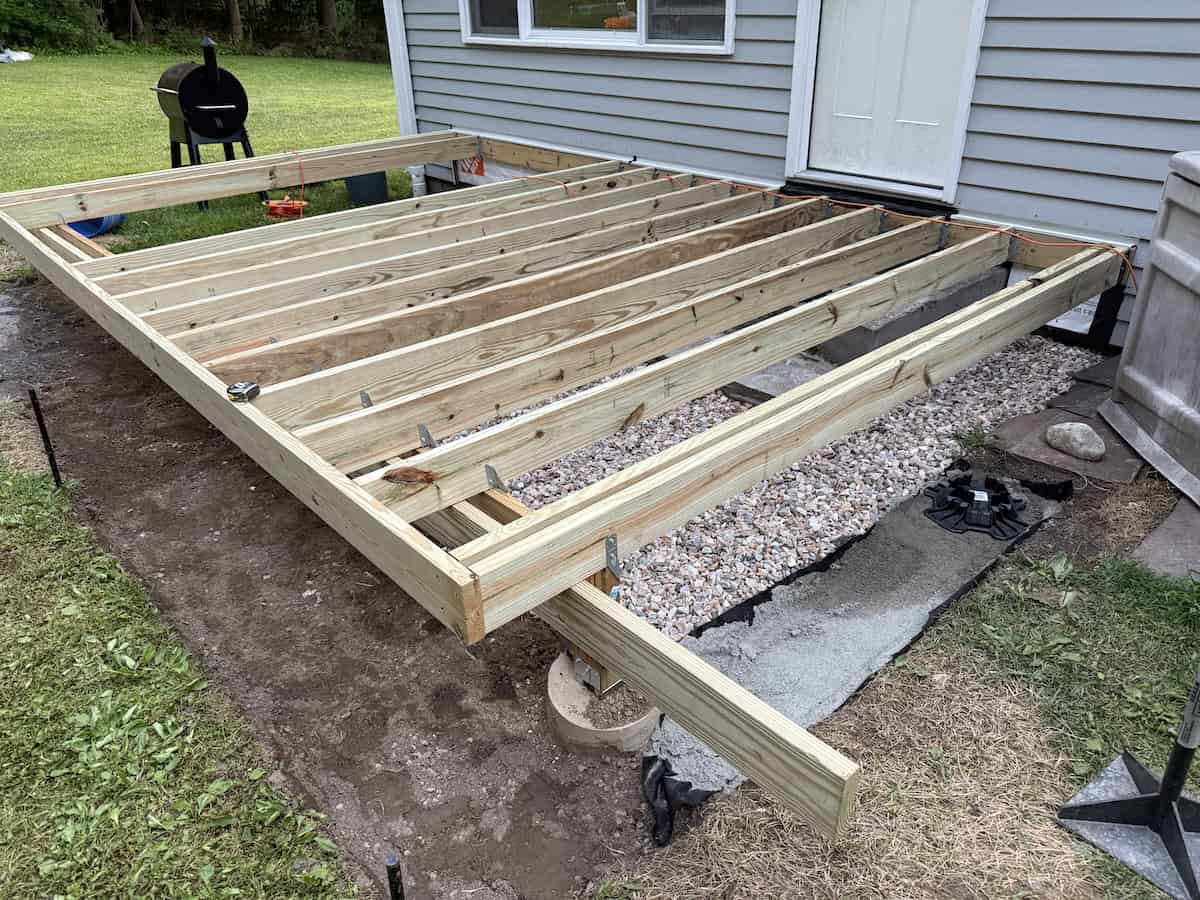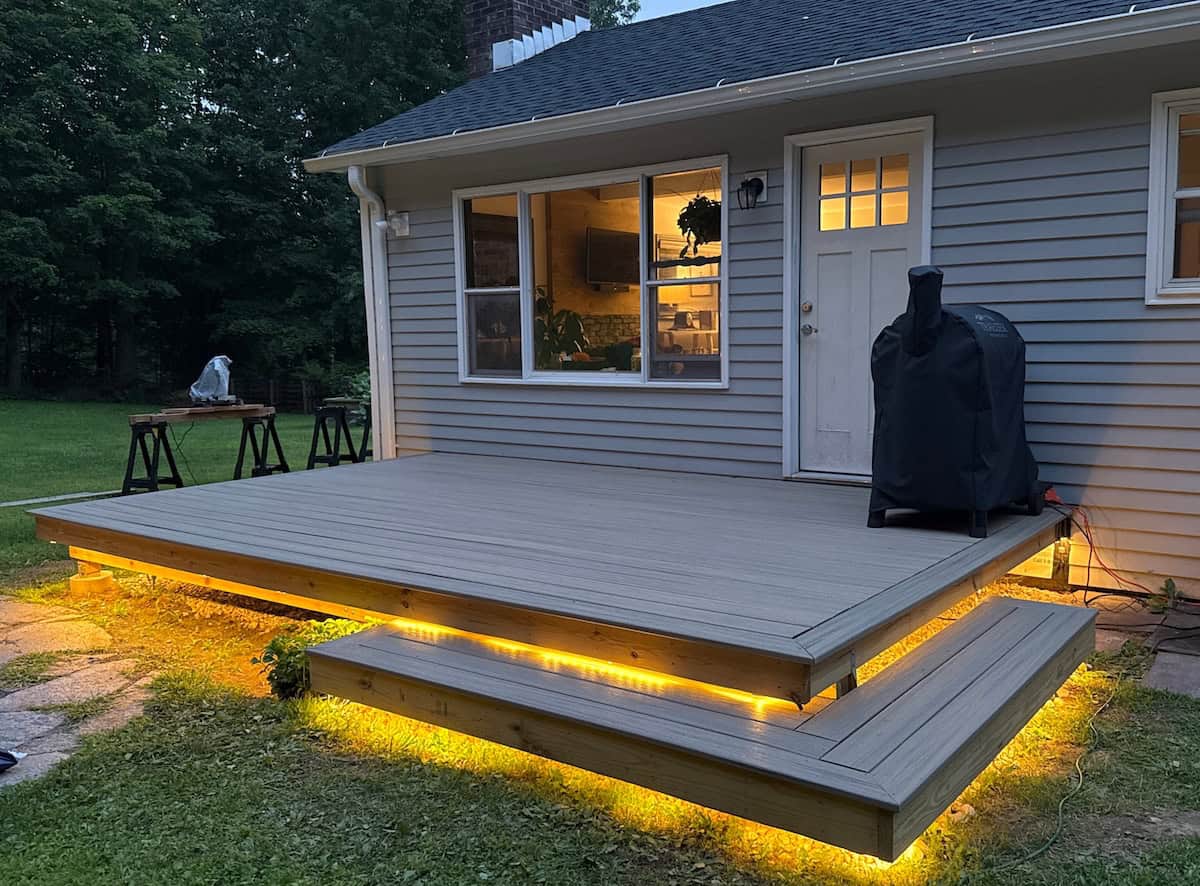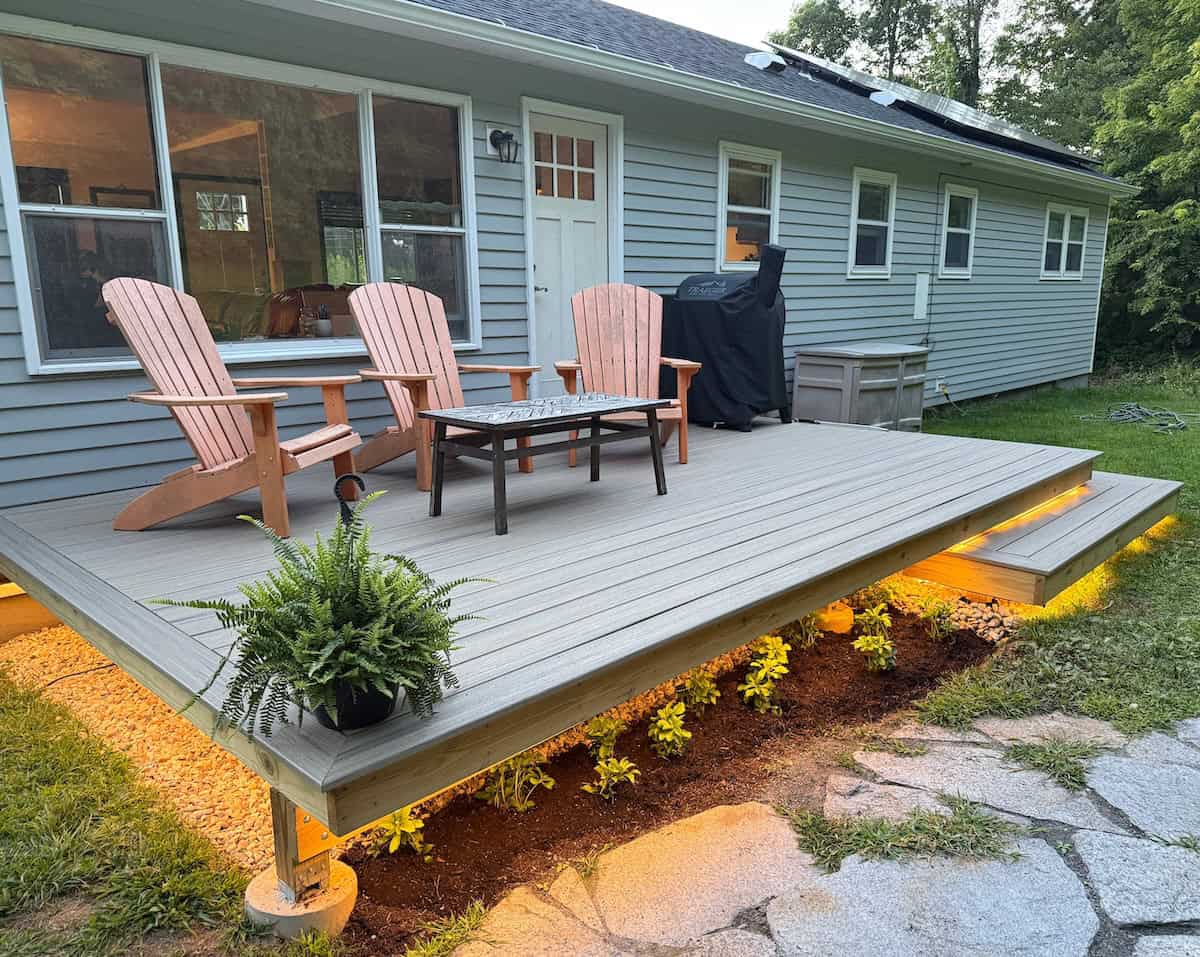“The journey of a thousand miles begins with one step.”
Assuming fifteen miles to Lowe’s in Torrington, five miles to Herrington’s in Lakeville, and three miles to Lindell’s in North Canaan, one step led to roughly 300 miles in Connecticut this summer.
My back step, specifically.
The grass that inexplicably sprouted from it, along with the shifting Brady Bunch-era slate on the top landing, convinced me that the entire flight had to go. Having tried my hand with an excavator a few times, I was not convinced I could rip it out without collapsing the adjacent wall of my kitchen, so I settled on the equivalent of sweeping it under the rug: burying it with a deck.
My primary job – the one for which I earned advanced degrees – is that of a high school principal. Familiar as I have become with the installation of white boards, the inner workings of industrial furnaces, and various floor waxing strategies, the construction of a deck naturally falls within my scope of practice. Armed with daily refreshers on the Pythagorean theorem and a working knowledge of physics, I set out to engineer a deck substantial enough to support myself and a few confederates while concealing the horror show of magically germinating concrete underfoot.
My carpentry apprenticeship has been decades in the making, beginning in middle school with a prefab birdhouse, then unceremoniously suspended for thirty-five years while I dabbled in the world of education. And although a masters degree in English has served me well in identifying iambic pentameter in the works of Chaucer, observations of high school geometry classes have done far more to stoke my desire to graft mathematical theory onto reality. In short: I wanted to make something.
However, any successful student of English 301 is forever plagued to deconstruct the meaning of something as simple as a deck, reading it as a perfect liminal space where one could invite Thoreau, Derrida, and the Pope for one banger of a dinner party. I had visions of twilight convivialities, accented with candlelight, clinking whiskey glasses, and the kind of existential riffing for which a dinner party with a slightly tipsy Thoreau, Derrida, and Pope is famous.

The Holy Trinity
I was clearly putting the theoretical cart way before the horse, because while I have never been averse to taking risks, I prefer that they be calculated ones. So before I started cutting into perfectly good cedar siding, I spent an inordinate amount of time on tasks for which I am more qualified, such as research (very qualified) and drafting (sorta qualified). This fed my need to gird myself with all manner of contingent considerations while simultaneously serving as an effective procrastination strategy. Etsy, YouTube, and Reddit were the Holy Trinity of opinionated forums on how to go about construction. Every two-bit DIY-er and erstwhile contractor had something to say about how to affix one piece of wood to another, and I gladly soaked in the warm bath of their admonitions.
At some point, though, it was time to get out of the theoretical tub and deal in the concrete. Literally. After consulting local building codes and weighing the virtues of five different types of footings, I opted for the most overbuilt and secure choice: poured concrete. My plans for the house side of the deck involved securing it to the rim joist of the house with a ledger board (more on all of this construction lingo later), and the commensurate security of three, 42”-deep concrete footings seemed like a real belt-and-suspenders way of holding up my most corpulent guests.
This meant groundwork, literally. I find the need to excessively point out that all of this work is literally happening because so many construction metaphors have worked their way into common usage and so many of them are especially well-suited to figurative, literary usage that I want to be clear that in this case, a writer is – uncharacteristically – working with his hands to create something tangible.
A nice companion piece – and procrastination resource – to my project was Michael Pollan’s A House of My Own, which chronicles the development and construction of a small writing hut in the backyard of the writer’s former house in Cornwall, CT. Although I’d read the book before for academic purposes, it took on new meaning in my parallel venture into home improvement, and I felt a kinship with his efforts to wring something square and flush from a brain most often employed in endlessly negotiating between words like “square” and “flush.” Removing those quotation marks would constitute a threshold (figuratively, this time).
The unfamiliar world of home improvement enriched my vocabulary. “Tolerance” was a threshold not to be crossed instead of a virtue to be sought. New and exotic terms entered my lexicon, and I can now confidently deploy words like “ledger,” “joist,” and “15-amp, 10-inch, corded compound miter saw” with moderate assurance that I will not elicit puzzled stares from the associates at Lowe’s. In fact, by the end of the project, I knew the store better than most of them.
Other words did not take on new meanings as much as earned new admiration. Square and flush are the sine qua non of any structure, and my return to the strictures of geometry shifted my thinking from terms of possibility to those of precision and certainty. Back to those footings.
The new Bob Vila?
We’re all familiar with the craftsman’s adage, “measure twice, cut once,” and it echoed in my brain at every turn. I measured out nine feet from my house, planning on footings that would support the outer edge of my deck, which would frame the edge of my fire pit with about a foot to spare. Having watched a clip from This Old House (starring the host whose name will forever be not-Bob Vila), I would construct batter boards (another new term!) to square them with the side of the house.
This was a monumental pain in the ass involving endless amounts of pink landscape string that provided a highly dissatisfying sense of squareness and that would eventually wind its way around every tool handle as I cleared the space of vegetation. To my way of thinking, squareness connotes rigidity, and string lines are the opposite of that, subject to every wayward breeze and forgetful step. Eventually, this led to the purchase of the coolest tool I now own, a laser level, which was only slightly more accurate, but came with lots of exciting and dire warnings along the lines of “you’ll shoot your eye out.” When I finally put spade to dirt, my prevailing thought was something like, “that’s about as good as you’re going to get.”
Because ultimately, I would be pouring a ten-inch circle of concrete into the ground, three-and-a-half feet deep. Permanent, yes, but there would be a margin of error about where I planted the anchor bolt, thanks to some niftily-engineered foot plates from my friends at Simpson Stong-Tie. From what I can tell, these dudes have a monopoly on joist and decking hardware that is well-deserved, and their hardware made up for my lack of carpentry skills. I’ve heard it said that any self-respecting carpenter will blanch at the suggestion of blending steel with wood construction, but having no reason to respect my carpentry skills, I went all-in on anything Simpson sells.
A borrowed one-half-inch drill made quick work of the concrete mixing, which was concerning. One can do a lot of permanent damage in a short amount of time with that kind of tool, and even with all of my measuring, my footings weren’t quite perfect – slightly ovoid and more off the mark than I’d hoped – but there they were, as immovable as the pyramids. Fortunately, another truism of woodworking played into my hand: wood is an imperfect medium. Individual pieces can be bowed and warped from the lumber yard, but they can also be bent to one’s will – to a degree – with the right tools and hardware. Instead of making the posts align with the outer rim joist of the deck, I opted to extend the deck to a full 10 feet and use the posts to anchor a supporting beam. The result was a longer deck that would make better use of the 10-foot 2 x 6s I had bought as well as provide some additional seating near my firepit. Win-win.

A DIY warrior
Once I solved that problem, it was time to take the monumental and ineradicable step of cutting into the house siding. Scores of YouTube videos had convinced me that this was the way to go to create the most stable deck, and although I wasn’t quite sure where the rim joist of the house was, I figured it had to be right under the back door, basically. The problem was that the house was primarily built atop several ginormous I-beams that would resist anything but an acetylene torch when it came to modification. The rim joist rested atop those beams but hidden with some sheeting and more or less decorative courses of siding.
I’d hired an actual carpenter to build out a closet in the house recently, and I’d noticed his deft use of an oscillating tool to make precise cuts around trim. This, along with the surety of the thousands I was saving by DIY-ing this stunt, convinced me of the necessity and long-term value of having such a tool in my arsenal. After another round-trip to Home Depot, I stood before the perfectly good siding, prepared to make permanent cuts where my new deck would rest. The vertical cuts were simple enough – thirty seconds with a power tool can undo hours of craftsmanship – but cutting through the nails and extracting the siding was a bit of a chore. After an hour, though, I stood before a sixteen-by-one-foot hole in my house, rather aghast at the damage I had done.
Nonetheless, like an archeologist, I had uncovered that apocryphal rim joist. It was dry, sturdy, and secure as the day it was installed, and my research suggested several strategies for keeping it that way. I wedged in some metal flashing and sealed every possible crevice with butyl tape in preparation for installing what would be the linchpin of the deck: the ledger board (or “bawd” as pronounced by the This Old House guy somewhere in Newton, MA).
By this point, I had become something of a lumber snob. I’d tried curbside pickup from Lowe’s, where the employees had hand-curated a selection of the most knotted, warped assortment of 2 x 4s this faceless customer had ever seen, so I now opted for my local lumberyard: Herrington’s. Here I was able to drive right into their sheds and select the finest 2 x 6’s this side of a Brazilian rainforest. It was as if someone had hand-raised a grove of southern pines for the express purpose of being screwed to my house.
And screwed they shall remain, thanks to a set of robust LedgerLOK 5” lag screws that I would trust with my life. Throughout the project, new conceptions of faith entered my consciousness. Faith in engineered solutions is one thing, but a higher devotion to the precepts of geometry is nearly a spiritual experience. Once the ledger had been secured to the rim joist of the house, framing could begin, employing the carpenter’s axiom of the 3-4-5 right angle, derived from the Pythagorean Theorem. Recalling a slightly un-square deck my father had built, I submitted to the strictures of geometry, fastidiously measuring and double-measuring all four corners of the deck, slightly incredulous that the math of an English major worked out every time.
From there, the rest of the deck fell into place – even a nifty floating step, inspired by Etsy, but requiring an additional 20 hours of YouTube-ing, flashbacks to high school physics, and trial and error to engineer. I even discovered strips of LED lighting that, when installed underneath the rim joist, could make it look like the control deck of the Death Star.
The decking itself was composite, delivered in 16-foot strips off the back of a Lowe’s flatbed. Through dumb luck, the planned length of my deck worked out to almost the exact length of these boards, so with square framing, it was just a matter of installing a mitred “picture frame” perimeter for them and then laying them in, one after the other. Although these ended up measuring an inch shorter near the house, the difference is not noticeable to the naked eye. I am not sure if that means that my math was off, but my calculations about the amount of lumber I needed certainly were. I had nine surplus pieces after accounting for some spares to keep on hand, and I had to rent a flatbed myself to haul them back to Lowe’s – an adventure that could be the subject of another article.
With each board, I knew that I was approaching the end of the project, just as I can now sense that I am getting to the end of this piece of writing. In the case of writing, dozens of similar essays have conditioned me to know exactly what I can say in about 1,500 words. But despite blowing past that number this time, I know that I have told the story of this deck, a process that has a clear beginning, middle, and end. I needed to lay some groundwork, explain some terms, include some necessary details, and communicate the arc of the process, much like writing. When the time came to drill that final screw into the last piece of decking against the house, I knew, viscerally, just like this article, that it was done.

